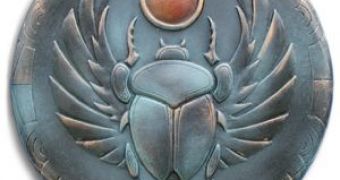Not far from the commercial center of Jerusalem, a 4,000 years old cemetery containing 30 to 40 tombs was accidentally found last summer by builders digging for a foundation.
It seems that the Canaanites, Semitic people arrived from Arabia to ancient Palestine and Phoenicia 5,000 years ago, had a much more extensive settlement in the city than previously believed.
Canaanite tribes gave rise to ancient Jews and Phoenicians. "Usually you find such sites completely looted, but here many of the tombs were discovered with all the artifacts inside them," said Gideon Avni, the Israel Antiquities Authority's director of excavations and surveys. "This is one of the largest concentrations [of artifacts] from this period."
Previously, this was the site of a sprawling depicting 1960s model of ancient Jerusalem, which was meanwhile moved to the city's Israel Museum in preparation for new construction. The site will offer a great deal of information about rural life in the Bronze Age Canaanite Jerusalem. "Jerusalem's agricultural settlement area [during the Bronze Age-roughly 4000 B.C. to 1000 B.C.] was much wider than what we thought up until now," said lead archaeologist Yanir Milevsky.
The ancient graveyard is situated on the edge of the Bayit Vagan neighborhood, overlooking Jerusalem's Emek Refaim ("valley of the ghosts"). "The cemetery sprawls over more than half an acre [0.2 hectare] and, according to evidence at the site, burials there were carried out primarily during the Bronze Age between 2200 and 2000 B.C. and 1700 and 1600 B.C.," said Melinsky.
The "shaft tombs", made by tunneling into the bedrock to burial caves, were common during Bronze Age Palestine. Among the discovered artifacts, there are copies of Egyptian scarabs (photo) used as talismans. The scarabs might have reached the Jerusalem area through trade with the Egyptians. "It's not uncommon here to find all kinds of ornamentation brought from outside the region," said Milevsky.
The archaeologists have also dug metal weapons, tools, and jewelry as well as fully preserved earthenware vessels. Burial rituals that suppose sheep and goat sacrifice are proved by the bones found in the site. The animals and foodstuffs stored in earthenware recipient served as "food for the dead". "This is another piece in the puzzle," said Avni.
"The Emek Refaim area was extensively inhabited during this time."
"We have evidence from the Mount of Olives area of similar tombs, and the city proper-the City of David site-was inhabited. [Bayit Vagan] was part of the peripheral network around Jerusalem."
There is more to be unearthed in the site. "Artifacts will likely be moved to the Israel Museum, Avni says, and the site itself would probably be reburied".

 14 DAY TRIAL //
14 DAY TRIAL //